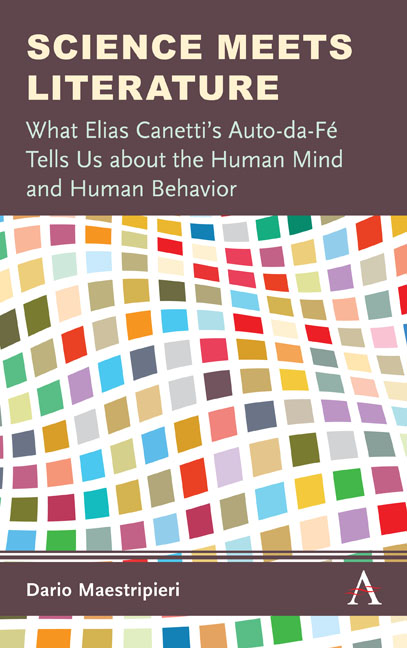 Science Meets Literature
Science Meets Literature Book contents
- Frontmatter
- Contents
- Preface
- Acknowledgments
- Chapter One Why Science and Literature?
- Chapter Two Elias Canetti: A Visionary Literary Genius on a Quest to Understand Human Nature
- Chapter Three The Plot of Auto-da-Fé
- Chapter Four Auto-da-Fé Is a Novel about Human Nature
- Chapter Five Major Themes Running Through Auto-da-Fé
- Chapter Six Analysis of Part I: A Head Without a World
- Chapter Seven Analysis of Part II: Headless World
- Chapter Eight Analysis of Part III: The World in the Head
- Chapter Nine Narrative Strategies in Auto-da-Fé
- Chapter Ten Consilience, the Canetti Way
- Elias Canetti: Chronology
- References
- Index
Chapter Five - Major Themes Running Through Auto-da-Fé
Published online by Cambridge University Press: 06 July 2019
- Frontmatter
- Contents
- Preface
- Acknowledgments
- Chapter One Why Science and Literature?
- Chapter Two Elias Canetti: A Visionary Literary Genius on a Quest to Understand Human Nature
- Chapter Three The Plot of Auto-da-Fé
- Chapter Four Auto-da-Fé Is a Novel about Human Nature
- Chapter Five Major Themes Running Through Auto-da-Fé
- Chapter Six Analysis of Part I: A Head Without a World
- Chapter Seven Analysis of Part II: Headless World
- Chapter Eight Analysis of Part III: The World in the Head
- Chapter Nine Narrative Strategies in Auto-da-Fé
- Chapter Ten Consilience, the Canetti Way
- Elias Canetti: Chronology
- References
- Index
Summary
Structure and Organization of the Novel
Canetti gave Auto-da-Fé a well-defined structure and a well-constructed plot, in which events unfold according to precise causal and temporal relationships. Canetti organized the novel into three parts: Part I: A Head without a World; Part II: Headless World; and Part III: The World in the Head. He was well aware of Aristotle's prescription “A whole is that which has beginning, middle, and end” (Poetics, The Art of Poetry). For example, as noted by Thomas Falk,
The third part of the novel brings all the carefully plotted elements to a successful conclusion, as is demanded by the Aristotelian definition of the well-constructed plot. The author will resolve the fate of the major characters and their lot in life in keeping with the way in which they were created. In addition, he will likewise dispose of the minor characters and events, so that there will be nothing left unresolved at the conclusion of the narrative. (Falk, 1993)
Besides Aristotle, Canetti was also clearly inspired by Balzac's La Comédie Humaine and by Dante's Divina Commedia (Divine Comedy). In La Comédie Humaine, Balzac divided human society into three worlds: workers and peasants, the bourgeoisie, and the aristocracy. Before concentrating on writing Auto-da-Fé, Canetti had planned to write The Human Comedy of Madmen, which was to be modeled after Balzac's Comédie Humaine. In Auto-da-Fé, Canetti did not use Balzac's identification of three strata of human society (unlike Balzac, Canetti had no interest in sociological analysis) but focused on the contrast between the intellectuals and the masses. In terms of structure of the novel, the Divine Comedy became the main model for Canetti's Auto-da-Fé. The Divine Comedy is divided into three books: Inferno, Purgatorio, and Paradiso. This tripartite structure reflected the religious/ Christian division of the world during the Middle Ages. The tripartite structure of the Divine Comedy does not only reflect a static representation of the world but also has a strong dynamic component as well, as Dante's journey through Inferno, Purgatorio, and Paradiso symbolizes his process of reckoning with his sins (and those of his contemporaries and of humankind in general) and then finding redemption.
- Type
- Chapter
- Information
- Science Meets LiteratureWhat Elias Canetti's Auto-da-Fé Tells Us about the Human Mind and Human Behavior, pp. 75 - 112Publisher: Anthem PressPrint publication year: 2019


